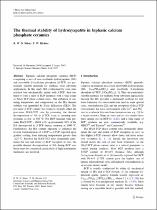JavaScript is disabled for your browser. Some features of this site may not work without it.
- ResearchSpace
- →
- Research Publications/Outputs
- →
- Journal Articles
- →
- View Item
| dc.contributor.author |
Nilen, RWN

|
|
| dc.contributor.author |
Richter, PW

|
|
| dc.date.accessioned | 2009-01-21T12:18:50Z | |
| dc.date.available | 2009-01-21T12:18:50Z | |
| dc.date.issued | 2008-04 | |
| dc.identifier.citation | Nilen, RWN and Richter, PW. 2008. Thermal stability of hydroxyapatite in biphasic calcium phosphate ceramics. Journal of Materials Science: Materials in Medicine, Vol. 19(4), pp 1693-1702 | en |
| dc.identifier.issn | 0957-4530 | |
| dc.identifier.uri | http://www.springerlink.com/content/p33115279485144w/ | |
| dc.identifier.uri | http://hdl.handle.net/10204/2875 | |
| dc.description | Copyright: Springer Science and Business Media. This is the post print version of the work. The definitive version is published in the Journal of Materials Science: Materials in Medicine, Vol. 19(4), pp 1693-1702 | en |
| dc.description.abstract | Biphasic calcium phosphate ceramics (BCP) comprising a mix of non-resorbable hydroxyapatite (HA) and resorbable b-tricalcium phosphate (b-TCP) are particularly suitable materials for synthetic bone substitute applications. In this study, HA synthesised by solid state reaction was mechanically mixed with b-TCP, then sintered to form a suite of BCP materials with a wide range of HA/b-TCP phase content ratios. The influence of sintering temperature and composition on the HA thermal stability was quantified by X-ray diffraction (XRD). The pre-sinter b-TCP content was found to strongly affect the post-sinter HA/b-TCP ratio by promoting the thermal decomposition of HA to b-TCP, even at sintering temperatures as low as 850 C. For BCP material with presinter HA/b-TCP = 40/60 wt%, approximately 80% of the HA decomposed to b-TCP during sintering at 1000 C. Furthermore, the HA content appeared to influence the reverse transformation of a-TCP to b-TCP expected upon gradual cooling from sintering temperatures greater than 1125 C. Because the HA/b-TCP ratio dominantly determines the rate and extent of BCP resorption in vivo, the possible thermal decomposition of HA during BCP synthesis must be considered, particularly if high temperature treatments are involved. | en |
| dc.language.iso | en | en |
| dc.publisher | Springer Science and Business Media | en |
| dc.subject | Biphasic calcium phosphate ceramics (BCP) | en |
| dc.subject | Hydroxyapatite | en |
| dc.subject | Bone substitute | en |
| dc.subject | Synthetic bone | en |
| dc.title | Thermal stability of hydroxyapatite in biphasic calcium phosphate ceramics | en |
| dc.type | Article | en |
| dc.identifier.apacitation | Nilen, R., & Richter, P. (2008). Thermal stability of hydroxyapatite in biphasic calcium phosphate ceramics. http://hdl.handle.net/10204/2875 | en_ZA |
| dc.identifier.chicagocitation | Nilen, RWN, and PW Richter "Thermal stability of hydroxyapatite in biphasic calcium phosphate ceramics." (2008) http://hdl.handle.net/10204/2875 | en_ZA |
| dc.identifier.vancouvercitation | Nilen R, Richter P. Thermal stability of hydroxyapatite in biphasic calcium phosphate ceramics. 2008; http://hdl.handle.net/10204/2875. | en_ZA |
| dc.identifier.ris | TY - Article AU - Nilen, RWN AU - Richter, PW AB - Biphasic calcium phosphate ceramics (BCP) comprising a mix of non-resorbable hydroxyapatite (HA) and resorbable b-tricalcium phosphate (b-TCP) are particularly suitable materials for synthetic bone substitute applications. In this study, HA synthesised by solid state reaction was mechanically mixed with b-TCP, then sintered to form a suite of BCP materials with a wide range of HA/b-TCP phase content ratios. The influence of sintering temperature and composition on the HA thermal stability was quantified by X-ray diffraction (XRD). The pre-sinter b-TCP content was found to strongly affect the post-sinter HA/b-TCP ratio by promoting the thermal decomposition of HA to b-TCP, even at sintering temperatures as low as 850 C. For BCP material with presinter HA/b-TCP = 40/60 wt%, approximately 80% of the HA decomposed to b-TCP during sintering at 1000 C. Furthermore, the HA content appeared to influence the reverse transformation of a-TCP to b-TCP expected upon gradual cooling from sintering temperatures greater than 1125 C. Because the HA/b-TCP ratio dominantly determines the rate and extent of BCP resorption in vivo, the possible thermal decomposition of HA during BCP synthesis must be considered, particularly if high temperature treatments are involved. DA - 2008-04 DB - ResearchSpace DP - CSIR KW - Biphasic calcium phosphate ceramics (BCP) KW - Hydroxyapatite KW - Bone substitute KW - Synthetic bone LK - https://researchspace.csir.co.za PY - 2008 SM - 0957-4530 T1 - Thermal stability of hydroxyapatite in biphasic calcium phosphate ceramics TI - Thermal stability of hydroxyapatite in biphasic calcium phosphate ceramics UR - http://hdl.handle.net/10204/2875 ER - | en_ZA |






